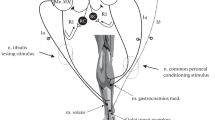Abstract
Changes in descending inhibition and facilitation evoked by stimulation of the nucleus fastigii were studied after injection of tetanus toxin into the relay nuclei of the medulla in experiments on cats under superficial pentobarbital-chloralose anesthesia. Injection of tetanus toxin into these nuclei leads to an increase in their “functional dispatch.” Descending inhibition (in response to injection of tetanus toxin into the gigantocellular nucleus) and descending facilitation (injection of the toxin into Deiters' nucleus and the nucleus ambiguus) were increased to many times their previous intensity, the latent periods of the descending effects were considerably shortened, their intensity rose sharply to a maximum, and their duration was greatly lengthened. To interpret these results it is postulated that powerful excitation generators are formed in the relay nuclei following disturbance of their inhibitory mechanisms. These results indicate that the “dispatch station” concept is applicable also to supraspinal structures.
Similar content being viewed by others
Literature Cited
A. D. Ado, G. V. Burlakov, and Yu. S. Sverdlov, Dokl. Akad. Nauk SSSR,167, 478 (1966).
G. N. Kryzhanovskii, in: Problems in Physiology and Pathology of the Nervous System [in Russian], Moscow (1962), p. 34.
G. N. Kryzhanovskii, Tetanus [in Russian], Moscow (1966).
G. N. Kryzhanovskii, in: General Neurophysiology and Experimental Pathology of the Nervous System [in Russian], Moscow (1970), p. 43.
G. N. Kryzhanovskii, in: Models of Diseases [in Russian], Moscow (1973), p. 120.
G. N. Kryzhanovskii, Pat. Fiziol., No. 4, 3 (1973).
G. N. Kryzhanovskii and F. D. Sheikhon, Byull. Éksperim. Biol. i Med., No. 11, 9 (1968).
G. N. Kryzhanovskii and F. D. Sheikhon, Byull. Éksperim. Biol. i Med., No. 7, 34 (1970).
G. N. Kryzhanovskii and F. D. Sheikhon, Exp. Neurol.,38, 110 (1973).
E. V. Montsevichyute-Éringene, Pat. Fiziol., No. 4, 71 (1964).
Yu. S. Sverdlov, Neirofiziologiya,1, 25 (1969).
F. D. Sheikhon, in: Problems in Physiology and Pathology of the Nervous System [in Russian], Moscow (1966), p. 119.
F. D. Sheikhon, G. N. Kryzhanovskii, and S. I. Igon'kina, in: Proceedings of the 11th Congress of the I. P. Pavlov All-Union Physiological Society [in Russian], Vol. 2, Leningrad (1970), p. 56.
F. D. Sheikhon, in: Brain and Movement (Abstracts of Proceedings of a Symposium) [in Russian], Erevan (1973), p. 160.
F. D. Sheikhon and M. B. Rekhtman, in: Convergence and Synapses [in Russian], Moscow (1973), p. 193.
A. Brodal, F. Wallberg, and O. Pompeiano, The Vestibular Nuclei [Russian translation], Moscow-Leningrad (1966).
V. B. Brooks, D. R. Curtis, and J. C. Eccles, J. Physiol. (London),135, 655 (1957).
M. B. Carpenter, D. S. Bard, and F. A. Alling, J. Comp. Neurol.,11, 1 (1959).
S. Grillner, T. Hongo, and S. Lund, Exp. Brain Res.,10, 94 (1970).
M. Ito, M. Udo, N. Mano, et al., Exp. Brain Res.,11, 29 (1970).
D. B. Lindsley, L. N. Schreiner, and H. W. Magoun, J. Neurophysiol.,12, 197 (1949).
H. W. Magoun, Physiol. Rev.,30, 459 (1950).
R. Naquet, H. Regy, and H. Gastaut, J. Physiol. (Paris),50, 428 (1958).
K. Sasaki and T. Tanaka, Jap. J. Physiol.,13, 64 (1963).
R. S. Snider, W. S. McCulloch, and H. W. Magoun, J. Neurophysiol.,5, 325 (1949).
J. M. Sprague and W. W. Chambers, Am. J. Physiol.,176, 52 (1954).
A. K. Tabécis and T. Ishikawa, Pflüg. Arch. ges. Physiol.,338, 273 (1973).
A. K. Tabécis and A. D. L. Maria, Brain Res.,40, 373 (1972).
F. O. Wallberg, O. Pompeiano, A. Brodal, et al., J. Comp. Neurol.,118, 49 (1962).
R. M. Wylie, Exp. Brain Res.,12, 128 (1971).
Author information
Authors and Affiliations
Additional information
Laboratory of Pathophysiology of Toxicoinfections, Institute of Normal and Pathological Physiology, Academy of Medical Sciences of the USSR, Moscow. Translated from Byulleten' Éksperimental'noi Biologii i Meditsiny, Vol. 79, No. 1, pp. 24–28, January, 1975.
Rights and permissions
About this article
Cite this article
Sheikhon, F.D., Kryzhanovskii, G.N. Suprasegmental inhibition and facilitation after injection of tetanus toxin into the medullary nuclei (the so-called dispatch station phenomenon). Bull Exp Biol Med 79, 23–27 (1975). https://doi.org/10.1007/BF00805495
Received:
Issue Date:
DOI: https://doi.org/10.1007/BF00805495



